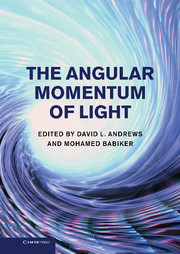Book contents
- Frontmatter
- Contents
- List of contributors
- Preface
- 1 Light beams carrying orbital angular momentum
- 2 Vortex transformations and vortex dynamics in optical fields
- 3 Vector beams in free space
- 4 Optical beams with orbital angular momentum in nonlinear media
- 5 Ray optics, wave optics and quantum mechanics
- 6 Quantum formulation of angle and orbital angular momentum
- 7 Dynamical rotational frequency shift
- 8 Spin-orbit interactions of light in isotropic media
- 9 Quantum electrodynamics, angular momentum and chirality
- 10 Trapping of charged particles by Bessel beams
- 11 Theory of atoms in twisted light
- 12 An experimentalist's introduction to orbital angular momentum for quantum optics
- 13 Measurement of light's orbital angular momentum
- 14 Efficient generation of optical twisters using helico-conical beams
- 15 Self-similar modes of coherent diffusion with orbital angular momentum
- 16 Quantum entanglement of orbital angular momentum
- Index
- References
10 - Trapping of charged particles by Bessel beams
Published online by Cambridge University Press: 05 December 2012
- Frontmatter
- Contents
- List of contributors
- Preface
- 1 Light beams carrying orbital angular momentum
- 2 Vortex transformations and vortex dynamics in optical fields
- 3 Vector beams in free space
- 4 Optical beams with orbital angular momentum in nonlinear media
- 5 Ray optics, wave optics and quantum mechanics
- 6 Quantum formulation of angle and orbital angular momentum
- 7 Dynamical rotational frequency shift
- 8 Spin-orbit interactions of light in isotropic media
- 9 Quantum electrodynamics, angular momentum and chirality
- 10 Trapping of charged particles by Bessel beams
- 11 Theory of atoms in twisted light
- 12 An experimentalist's introduction to orbital angular momentum for quantum optics
- 13 Measurement of light's orbital angular momentum
- 14 Efficient generation of optical twisters using helico-conical beams
- 15 Self-similar modes of coherent diffusion with orbital angular momentum
- 16 Quantum entanglement of orbital angular momentum
- Index
- References
Summary
Introduction
There exist two well-established methods to trap charged particles: the Penning trap [1] and the Paul trap [2]. In the Penning trap the particle is confined in space by a combination of static magnetic and electric fields. In the Paul trap the trapping is caused by a high frequency electric quadrupole field. The subject of this article is to present a third mechanism for trapping charged particles – trapping by beams of electromagnetic radiation. It was discovered some time ago [3–6] that a properly prepared beam acts as a “waveguide” for particles, confining their motion in the transverse directions. Similar phenomena occur in RF fields [7]. In all these cases, the essential role is played by the electric field configuration in the plane perpendicular to the beam axis (for nonrelativistic electrons, the magnetic field is less important). Particles are confined to the vicinity of the minimum-energy points. In particular, for beams of electromagnetic radiation carrying orbital angular momentum such points lie on the beam axis. One beam may confine particles only in the transverse direction. Two or three crossing beams may fully confine particles, acting as a substitute for the Paul trap.
Trapping of charged particles by beams of electromagnetic radiation is based on the same general principles as the Paul trap. In the Paul trap the quadrupole radio-frequency field is produced by a system of electrodes. In our case, the field is that of freely propagating electromagnetic beams. In both cases the essential role is played by two factors: the proper shape of the force field and fast oscillation or rotation. These features are clearly seen when we invoke the notion of the ponderomotive potential.
- Type
- Chapter
- Information
- The Angular Momentum of Light , pp. 264 - 283Publisher: Cambridge University PressPrint publication year: 2012
References
- 4
- Cited by

